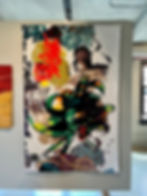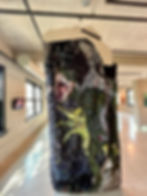Abstraction, Representation and a T-Rex
- Camilyn Leone
- Sep 17
- 6 min read

Tapestry Travels
ATA Biennial 15
Camilyn K. Leone
Sept. 16, 2025
American Tapestry Biennial 15 will be on view at the Epiphany Center for the Arts in Chicago, IL through September 26, 2025. To see a schedule of when you can visit this amazing tapestry exhibit go to:
Outside of the Golden Hours programming, most Wednesdays to Saturdays from 5-8 pm, you need to make an appointment. To make an appointment to see the exhibit contact a member of the Epiphany Center staff at art@epiphanychi.com
Epiphany Center for the Arts
201 S Ashland AveChicago, Illinois 60607(312) 421-4600
The mission of the Epiphany Center for the Arts is: to instill an artistic, cultural experience in all patrons who cross our threshold with the hope that each will be inspired to realize their own Epiphany.
The Epiphany Center accomplishes its mission with the American Tapestry Alliance Biennial 15.
As a new tapestry weaver, I was surprised, challenged and delighted by the artists selected for the exhibition. I saw tapestries by well-known tapestry educators and artists as well as many artists that I had never heard of. I saw techniques and designs that reference classical Aubusson methods such as weaving from the back of the loom and contemporary tapestries that were made without a loom. There were several tapestries that told stories about politics, identity, the environment and other more personal stories.
The Epiphany Center for the Arts is in the West Loop. It is about a 10–15-minute cab ride from Michigan Avenue. The first thing that you notice about the West Loop are the old warehouses and other industrial buildings that have been converted into apartments, restaurants and businesses. There is lots of sky because there are only a few skyscrapers in this area of town.

The Epiphany Center is an 1885 Episcopal church. The style of architecture is Romanesque. The exterior features heavy stone and archways. The restored interior is equally dramatic with lots of stained glass and painted architectural details. The building was repurposed in 2017. There are several gallery spaces, resident artist studios, performance, event and dining spaces. The ATA exhibition is in the largest gallery that is naturally lit from two sides. There are moving walls so that the gallery can be reconfigured so that each tapestry has the best light and vantage point for the viewer.
Since I was unable to attend one of the Golden Hour events, I sent an email to find out other times when I could visit. Esme quickly responded and helped me make an

appointment to see the show. This was amazing because I traveled to Chicago from Charlottesville, Virginia! Upon my arrival, Esme welcomed my guest and me to the Epiphany Center. She explained the history of the Center, escorted us to the gallery and invited us to enjoy the exhibit. She also showed us the other gallery spaces and told us about the other current artists exhibiting at the Center. It was a real privilege to be able to see the tapestries on a Friday afternoon and to have so much time to enjoy them. I would encourage anyone to take advantage of the chance to make an appointment to see this exhibit. The show is up until Sept. 26 so make your plans.
Of all the wonderful tapestries that I saw, I was particularly moved by a few. One was abstract, another was representation and the third tapestry that I write about has a T-rex.

Upon entering the gallery, I saw Lialia Kuchma’s Ukraine War #4, 2024. This abstract tapestry conveys emotions and concepts through color, shape and texture. The reds, oranges and yellows and the jagged shapes evoke the sensation of an explosion or sonic boom. The grey shapes at the top and the bottom of the composition balance the hot colors. To my eye, the grey shapes are like clouds from fire and destruction. The finely blended heathered white background creates a sensation that we are viewing events from the sky. The viewer can be distant from the scene if that is the way she chooses to experience this tapestry. Or the viewer can move in close, approach the ground and feel what’s going on near the battle. Kuchma has created an image that allows the viewer to interpret the story from a personal point of view. Through abstraction, Kuchma communicates the totality of war, from hopelessness to hope. It is a tapestry telling a story set in the past, the present and the future. This is the epitome of the power of abstract art.

In contrast, Annie Landry’s En Souvenir de grand-père 2023, representation dominates the subject matter. Grandad is woven wearing clam digging attire and he is holding a clam rake. He has his baseball cap, his glasses and his suspenders on. His dark tan and fit physique tell the story of a man who loves being outside and works hard. Then something happens to make this more than a moment in time. Abstraction leads us to another dimension. Grandad dwells in a world of prismatic color, shifting light and rippling waters. It’s almost as if the viewer is looking straight into the sun and might lose sight of Granddad. The composition is grounded by the boat structure created with dark color around shifting reflections. A horizon line defines the blended threads and makes them a sky. If you squint, the image changes. You may see granddad, or you may see shimmering color and form. Like water, there is a sensation of something always there and always moving. It is this interplay of abstraction and representation that is so brilliant. I don’t know Annie Landry’s art, but I look forward to learning about it!

Dance Doyle’s Tempest 2024 drew me in. The tapestry stands about 9 feet tall and 5 feet wide. From across the gallery, I was like, “what the heck is that?” Then, I noticed a female skeleton like figure with painted pink toenails. I immediately connected with the pedicure. She appears to be attacking a T-rex with a heart shaped tongue. In the background, there is a Pac-Man game. Being a human, I immediately began to make meaning of the collage of images. Pac-Man wants to eat and avoid being eaten by ghosts. Is the female figure a ghost? Is the T-rex Pac-Man? Is the T-rex a bad dude that the female dated? Is the ghost going to eat T-rex who is a good guy? There are lots of symbols in the tapestry to suggest answers to these questions. Beyond the symbolism and pop-culture references, there is a mix of

materials: hand-dyed wool, silk, cotton, linen, goat cashmere, glow-in-the-dark yarn, vintage metal twine, feathers, a metal necklace, and mixed media. The glow in the dark wool reminds me of Halloween parties. Feathers make me think of boas and burlesque performances. A metal necklace might be a gift from a lover. From a tapestry weaver’s point of view, this tapestry is unique because you can see the back. I felt as if I was seeing the artist tapestry secrets, at least in the weaving! It’s a behind the scenes look at Doyle’s weaving technique. You can see how the materials are woven together to create as many stories as viewers of Tempest.
These are just a few of the remarkable tapestries that I saw at the ATA Biennial. I could write reams about the other artists, and maybe I will. But, for now, I hope that I have motivated you to go to the Epiphany Center and see the show.
I’ve had a tapestry epiphany. You might too.

Many thanks to the Epiphany Center for the Arts and to Esme for arranging my visit.
Lialia Kuchma Ukraine War #4 2024 Details


Annie Landry’s En Souvenir de grand-père 2023


Dance Doyle’s Tempest 2024 Detail from the back.

